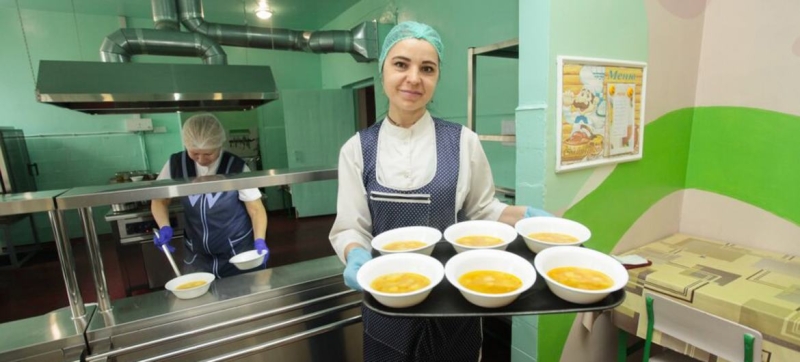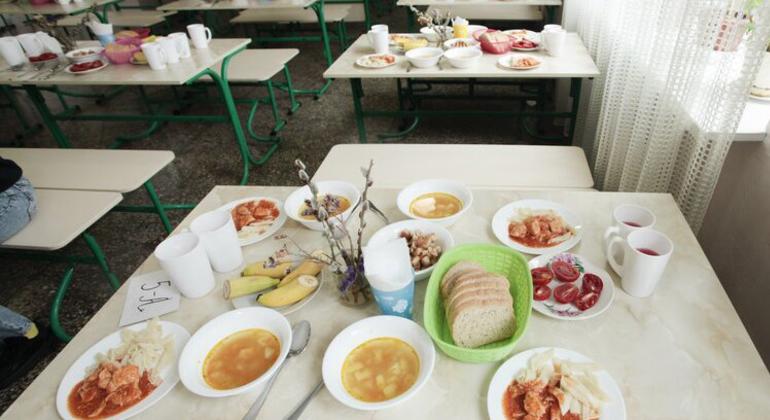
Canteen at the Velikomikhailovsky Lyceum. School lunches in Ukraine: nutrition and confidence in the future Peace and Security
Every day at 10:15 a.m. in Velikaya Mikhailovka, Odessa region, about 100 children aged six to 10 line up for lunch in the school cafeteria. The delicious smell coming from the kitchen makes it difficult for them to stand still and follow the teachers’ instructions. Today the menu includes pea soup and pasta with meat, as well as compote and bananas.
Over the previous week, an air raid warning was announced in this village seven times. Velikaya Mikhailovka is located relatively close to the sea, which is why it is at the center of the conflict. Attacks on nearby populated areas are also very common.
Locals take air raid warnings seriously, as they mean that missiles or drones with explosive charges are approaching.
Despite the dangerous situation, about 6 thousand people live in the village. The Lyceum in Velyka Mikhailovka is among 700 Ukrainian schools whose meals are supported by the World Food Program (WFP). Initial funding for this initiative, which helps provide daily nutritious meals to 100 thousand children in Ukraine, was provided by the French government and Mastercard.
Difficult to explain
This year, one lunch at school costs 50 hryvnia ($1.29) per day. Thus, feeding one child would cost approximately $26 per month, while the minimum wage in Ukraine is $185.
“It’s difficult to explain to young children why some people go to lunch and others don’t,” says school director and math teacher Natalya Kravchenko. “In particular, this applies to children from disadvantaged or poor families whose parents cannot afford to pay for food in the canteen.”
“We are therefore very pleased that our school is participating in the World Food Program School Feeding Initiative,” she added.
Kravchenko has been running the lyceum for 18 years. And in 1977, she herself was a first-grader there when the institution first opened.
Pea soup
Her main goal during the war was to maintain normal conditions for children.
During an air raid raid, the students are taken to a shelter in the school basement. However, the basement cannot accommodate all the schoolchildren at once, so Kravchenko decided to divide the education into two shifts: elementary school students begin the school day at 8 a.m., and high school students at 11:30 a.m.
The upper grades are also divided into two groups that alternate between in-person and remote learning each week.

First-grader Maria has already finished pea soup, her favorite dish, and her classmate Dasha says she prefers pasta.
Roman, Maria’s father, works as a physical education teacher. Finding work in the village is difficult: due to the uncertainty associated with the war and regular raids, there are few open businesses and no plans to create new jobs. Therefore, most vacancies can be found in government institutions such as schools, hospitals and village councils.
“Both my wife and I have jobs,” he says. – Maria’s mother, Yaroslava, works at another school.”
According to Roman, they are lucky, because there are children whose parents cannot even afford to buy them fruit.
Delicious cutlets
Dasha’s mother Oksana says that her youngest daughter has to get up for school at 6:30 in the morning , and it’s difficult to feed a six-year-old child at such a time. In addition, due to the war and changing daily routines, it is difficult to find enough time to prepare food. Oksana has one child in elementary school, another in high school, and the woman herself needs to go to work.
“Sometimes I come home and ask her: “Dasha, will you eat?,” and she replies: “No, I already ate at school, the cutlets and fish there are so delicious!” says Oksana. “This way I understand that my child eats healthy food at school, and I save a significant part of the family budget.”
The WFP school feeding program covers 30 percent of the cost of daily hot meals for children in grades 1–4. This helps ease the financial burden for parents, especially those who are struggling to make ends meet.
In February, thanks to WFP support, a hot lunch at the Velyka Mikhailovka school cost only 0.16 hryvnia – that’s $0.004. Thanks to lower prices, the canteen now serves 125 students, compared to 90 at the beginning of the year.
Read also:
The new program will support more than 150 thousand schoolchildren in Ukraine
Daily meals also provide an important sense of stability during war. Many children and their families were forced to leave their homes due to the fighting and are now rebuilding their lives, which could be disrupted again at any moment.
“If it weren’t for the war, we would already be planning a second child,” says Maria’s father Roman. – But the situation here is complicated. Since Russian-occupied Transnistria is only 30 kilometers away, fighting could break out at any moment. So my car is always gassed up and our things are packed in case we have to run.”
